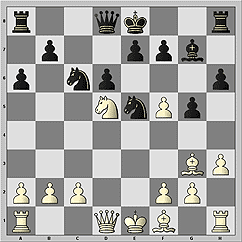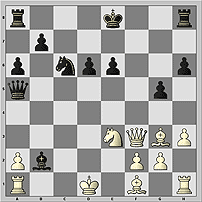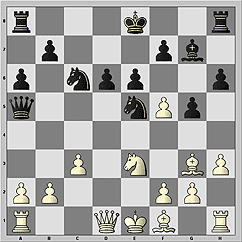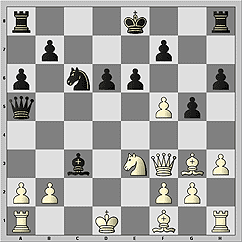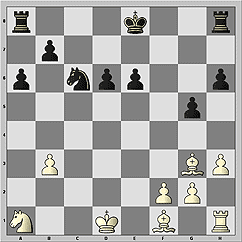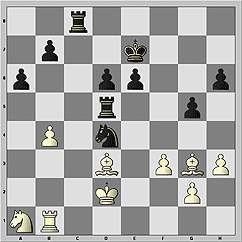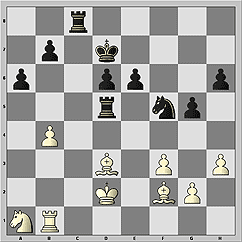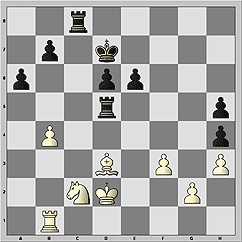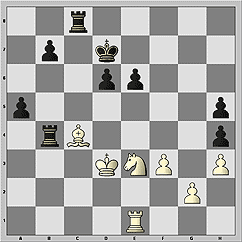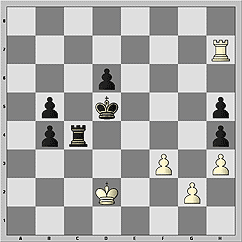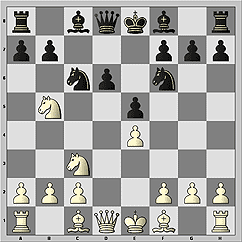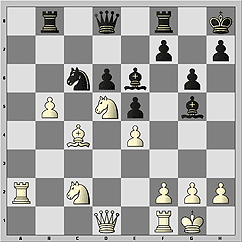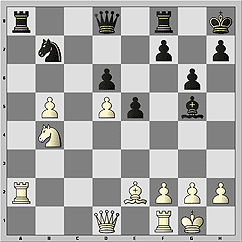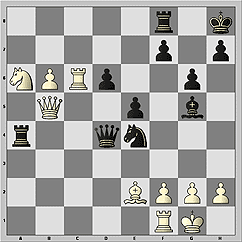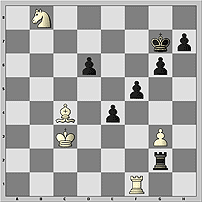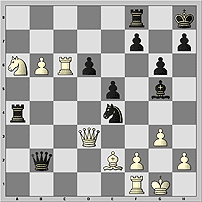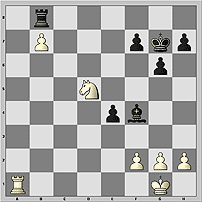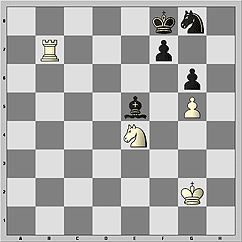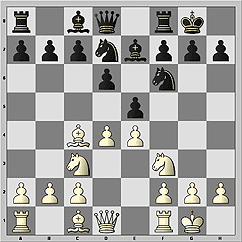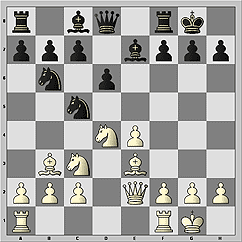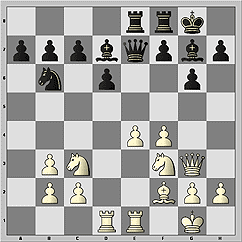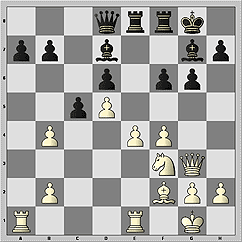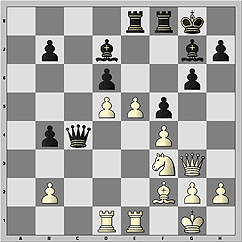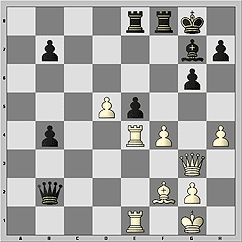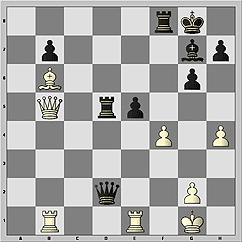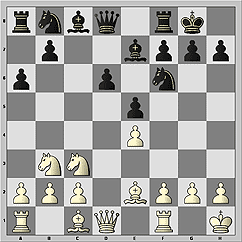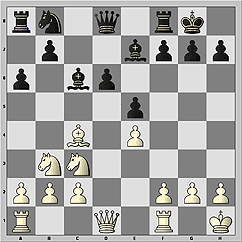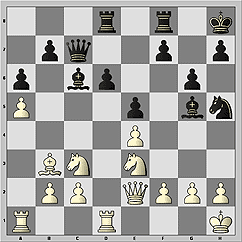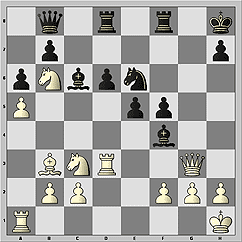 | Последние турниры |
Чемпионат России
СуперФинал

02.12.2006
Суперфинал чемпионата России проходит в Москве, в ЦДШ им. М.М.Ботвинника со 2 по 15 декабря при 12 участниках по круговой системе.
Крамник - Fritz

25.11.2006
С 25 ноября по 5 декабря в Бонне чемпион мира Владимир Крамник сыграет матч из 6 партий с программой Deep Fritz. В случае победы Крамник получит 1 миллион долларов, тем самым удвоив свой стартовый гонорар ($500000).
Мемориал Таля

5.11.2006
В Москве с 5 по 19 ноября проходил Мемориал Таля, в программе которого супертурнир 20-й категории и выдающийся по составу блицтурнир. Призовой фонд каждого состязания - 100.000 долларов.
Топалов - Крамник

23.09.2006
После того как "основное время" не выявило победителя (счет 6:6), 13 октября соперники сыграли 4 дополнительных поединка с укороченным контролем времени.
Томск. Высшая лига

2.09.2006
Со 2 по 11 сентября Томск принимает Высшую лигу чемпионата России 2006 года. В турнире участвуют 58 шахматистов - как получившие персональные приглашения, так и победившие в отборочных состязаниях.
Майнц

17.08.2006
В последние годы фестиваль в Майнце вслед за "Амбер-турниром" стал центром легких шахматных жанров. Наряду с массовыми ристалищами традиционно проходят чемпионские дуэли.
Россия - Китай

10.08.2006
С 10 по 20 августа в Китае проходит товарищеский матч сборных России и Китая. В нынешнем поединке как мужчины, так и женщины соревнуются на пяти досках по шевенингенской системе в два круга.
Все материалы
ChessPro

|
|

|
|
 |
By grandmaster
Sergey SHIPOV |
“Hare” is running too fast! |
In middle and long distance race of field athletics there is a good method to show good results. One of athletes leads about half of the distance sets up a high pace, whereas the main favorites hide behind him sparing energy and spurt closer to the finish, when the exhausted “hare” (it is a universally recognized term) drops out of the race.
In San Luis Topalov is running through the tournament distance faster than the quickest hare in the world. The Bulgarian has no desire to make way for other contenders. Nobody can keep up with Veselin. None is capable of fighting with such commitment and determination! Kasparov, Fischer and Alekhine played so at their best! Many dream about joining such high ranks but where to refuel so much energy?
Peter Svidler did his best to beat the leader. It became clear that the only chance to outdistance Topalov was to win over him. However, Peter did not succeed…
In the game of two leaders White had some problems right in the openings. Although the battle could have gone either way, the opening handicap redounded upon Peter.
Sicilian Defense B90
Peter SVIDLER (RUS) – Veselin TOPALOV (BUL)
1.e4 c5 2.Nf3 d6 3.d4 cxd4 4.Nxd4 Nf6 5.Nc3 a6 6.Be3 Ng4 7.Bg5 h6 8.Bh4 g5 9.Bg3 Bg7 10.h3 Ne5 11.Nf5 Bxf5 12.exf5 Nbc6 13.Nd5. I was sure that Peter was going to follow the track of the fourth round encounter Kasimdzhanov – Anand, but his last move came as surprise.
13...e6 14.Ne3. In most cases it is just a harmless transposition but why should why give the opponent some extra options? Whatever Peter’s ideas could be, he failed to implement them… It is clear that the following game was the basis of Topalov's novelty – 14.fxe6 fxe6 15.Ne3 Qa5+ 16.c3 Nf3+!? 17.Qxf3 Bxc3+ 18.Kd1 Bxb2
19.Rc1! Bxc1 20.Nc4! Qxa2 21.Qf6 Qb1 22.Qxe6+ Kf8 23.Qxd6+ Kg7 24.Bd3 Bf4+ 25.Bxb1 Bxd6 26.Nxd6 Rhd8 27.Kc1 Rd7 28.h4 Rad8 29.Nf5+ Kf8 30.hxg5 Rd5 31.Rxh6 Rd1+ 32.Kb2 R8d2+ 33.Bc2, and Black resigned (Cheparinov – Ibarra Jerez, Roquetas de Mar 2004). Probably Ivan Cheparinov pointed out to his teammate that White’s posiiton was not so great in this line. It looks like Peter swallowed the outcome of this game and did not analyze it in depth.
14...Qa5+. Nominally, that is a novelty. As a matter of fact, the pawns f5 and f7 does not change the situation very much. Black also tested 14...0–0 15.c3 d5 16.fxe6 fxe6 17.Be2 Qe7 18.0–0 Rad8 19.Qe1 Ng6 20.Rd1 Nf4 with a good position (Bromberger – Berczes, Budapest 2004); and 14...Qe7 15.Be2 0–0 16.0–0 d5 17.c3 Rad8 18.fxe6 Qxe6!? 19.Nc2 d4 20.cxd4 Nxd4 21.Nxd4 Rxd4 22.Qc1 Rc8 23.Qe3 Rc2 24.Rad1 Nc6 25.Bg4 Qxe3 26.fxe3 Rdd2 27.Rxd2 Rxd2 28.Bh5 Rd7 29.b3, with an roughly endgame (Spasov – Elsness, Gothenburg 2005).
15.c3. The most aggressive continuation; the queen exchange on d2 results in a roughly equal ending.
15...Nf3+! (Topalov played this move straight off; no doubt, it was his home preparation) 16.Qxf3. The line 16.gxf3 Bxc3+ 17.bxc3 Qxc3+ 18.Ke2 (18.Qd2 Qxa1+) 18...Nd4+ is unacceptable for White as he loses his queen.
16...Bxc3+ 17.Kd1. The only way to maintain material equilibrium.
17...Qa4+! Here comes the real novelty, most likely found by Cheparinov in the post-mortem. Actually, after 17...Bxb2 18.fxe6 Black does not have to capture on c6 transposing into the above mentioned game Cheparinov – Ibarra Jerez. Much better is 18...Qa4+ 19.Kd2 Qb4+ (the only move) 20.Kd1 and only here 20...fxe6 – White does not have the maneuver Ne3-c4xd6.
18.Nc2. After 18.Kc1 Bxb2+ 19.Kxb2 Qb4+ 20.Kc1 Nd4 21.Qd1 Black can deliver perpetual with his queen on с3 b4. A more aggressive line 21...Rc8+ 22.Bc4 Qc3+ 23.Kb1 Rxc4 24.Nxc4 Qxc4 also deserves attention as White has some problems bringing his a1-rook into play. Actually, the perpetual seems to be inevitable even in this variation.
18...Bxb2 19.fxe6 fxe6 20.Qb3. In case of 20.Qg4 could have kept the queens on the board – 20...Nd4! 21.Rc1 Rc8 22.Bd3 Kd7 , with a dangerous intitative
20...Qxb3 21.axb3 Bxa1 22.Nxa1. So what are Black’s achievements? He has 20 extra minutes on his clock! In this his roughly equal position both opponents should play with precision. What does it take? Exactly, energy and time! Topalov was better in both components.
22...Ke7. The black rooks do not have the maneuver room. Black should quickly launch active operations as White’s numerous pieces are uncoordinated. Any delay gives white an upper hand. Both opponents were fully aware of that.
23.Bd3. In course of on-line coverage and right know I think that White should have started with a more precise 23.Kd2! His further arrangement of the pieces depends on Black’s next move. For example if the knight goes to d4, the White can start transferring his bishop from g2 to f2. After 23...Rac8 the move 24.f3 deserves attention. By the way in this case White can develop his h1-rook with h3-h4.
23...Rac8. The continuation 23...Nb4 with the idea of 24.Bb1 a5! followed by a5-a4 suggested itself. Opening the a-file would be very useful for Black. Probably White should retreat his bishop to either e4 or g6. There are many subtleties in this position…
24.Re1. White deliberately leaves his knight at the edge of the board. Peter hopes that sooner or later he will brings it to play. However it was not such an easy task. It looks like White missed a good moment to do it right now. Probably Peter discarded 24.Nc2!? in view of 24...Na5. I think that White has a good counterplay in the line 25.Nd4! e5 26.b4 Nc4 27.Nf5+ Kf6 28.Ke2 – at least all white pieces participates in the battle.
24...Nd4! Plugging up the rook in the corner.
25.f3 (right decision; the bishop is heading to f2. After 25.Nc2 Nxb3 26.Bf5 e5 27.Bxc8 Rxc8 Black has good chances in the endgame with tree pawns for a piece) 25...Rc3 26.Kd2 Rhc8 27.Rb1. Again, Black had nothing against trading his rook for the bishop and the pawn – 27.Bc4 R8xc4 28.bxc4 Rxc4. In this line his is not worse to say the least.
27...R3c5 28.b4 (28.Bf2 is also met with 28...Rd5!) 28...Rd5. Black has no fear of the white’s bishops attacks. The discovered check is a good antidote in all the lines.
29.Bf2 (here is the tactical ground of the black rook’s maneuver – 29.Be4? Nxf3+ 30.Ke2 Rd2+ 31.Kxf3 Rc3+ 32.Kg4 Rd4 33.Re1 Rxb4!–+) 29...Kd7. From this moment both opponents started surprising the spectators and annotators with every move! I considered the sequence 29...Nc6 30.Ke2 Ne5 31.Be4 Rb5 32.Nc2 d5 33.Bh7 a5 as the main line. It is very hard to evaluate this position. White managed to bring the knight into play. It is a weighty counterargument.
30.Be3. Alas, the pawn sacrifice in the line 30.Nb3 Nc6 31.Ke2 Nxb4 32.Be4 with the idea of 32...Re5 does not work in view of 33.Bg3 Rb5 34.Nd4 Rb6 35.Bf2! and the black rook on b6 falls under fire. Much better is 32...Na2! and Black forces favorable exchanges with the knight infiltration to с3. The variations with the black rook taking up d5 are more complicated here – 30.Be4 Nxf3+ 31.Ke3!? Rc3+ 32.Ke2 Rd2+ 33.Kf1 Rxf2+! (33...Nd4 34.Be1!) 34.Kxf2 Nd2 35.Re1 Nxe4+ 36.Rxe4 d5 37.Re2 Kd6 38.Nc2 Rc4 – White should think how to save the game and probably it is too late! Black’s pawn advancement is very difficult to contain.
30...Nf5 31.Bf2. At this point Veselin displayed the maximalism of a real champion. He decide to push for win running risks of losing the game. His gambling paid off!
31...Nh4 (after 31...Nd4 the most likely would have been drawn by repetition) 32.Bxh4 gxh4. Black has traded White’s powerful bishop and opened the file for his rooks to attack the g2-pawn. It is not bad, but White is bringing one piece into play…
33.Nc2! h5. Black’s desire to restrict the knight is quite understandable.
That is the most important moment of the game!
34.Re1. Wrong implementation of a sensible plan. White is going to advance his rook to the fourth file and snatch the h4-pawn. However, this plan if foiled by the force of circumstances. Much better was 34.b5! In my opinion Black would have play with accuracy to save the game. The move 34...a5 does not promise much. Black’s passer is not that dangerous when White’s pieces are no far away – 35.Ra1 b6 36.Ra4. Then White transfers the knight to e3, advances his pawn from f3 to f5 with a slight advantage.
34...Rg8 35.Kc3. It looks like miscalculation. White is going fork the black rooks with the knight. 35.Re2 is bad simply because it is inconsistent with White’s last move. His plan was to place the rook to e4. There is a lot of fight there, but Black is just slightly better.
35...a5! A highly unpleasant surprise for White. Black is clearing the c5-square to retreat from the rook with check.
36.Bc4? White made his first and last serious mistake in the game. Being in the time trouble Peter lost his head and failed to put up resistance. He should have played 36.bxa5 with poker face and in case of 36...Rxg2 quickly react with 37.Nd4! – with active pieces a draw was quite attainable. Check out the following entertaining line – 37...Rc5+ 38.Kb4 Rb2+ 39.Ka3 Rf2 40.Bb5+ Rxb5 41.Nxb5 Rxf3+ 42.Kb4 Rxh3 (42...Rf4+ 43.Kb3 Rf3+ 44.Kb4=) 43.Rc1! and it is Black who has to look for a safe harbor.
36...Rc8! (this pin is deadly for White) 37.Ne3 (other options are no better;37.Kb3 a4+! or 37.bxa5 Rdc5 38.Ne3 d5) 37...Rb5! The most precise move.
38.Kd3 Rxb4.
39.Bxe6+ (It is impossible to stop so many passers by the ordinary means) 39...Kxe6 40.Nc2+ Kd5 41.Nxb4+ axb4 42.Re7 b5 43.Rh7 Rc3+. Simpler was an immediate 43...Rc4!
44.Kd2 Rc4! That is not bad either! Against the opponent’s pair you don’t really care what to have three of the kind or street. The b4-pawn is unstoppable. Svidler resigned.
After 45.Rxh5+ Kc6 46.Rh8 b3 47.Re8 Black don’t even need to calculate the pawn ending arising after the rook exchange on c1. The rook endgame is even easier to win – 47...Kc5! and the king shepherd the pawn to the first rank
The next game is very interesting from theoretical standpoint.
Sicilian Defens B33
Vishwanathan ANAND (IND) – Peter LEKO (HUN)
1.e4 c5 2.Nf3 Nc6 3.d4 cxd4 4.Nxd4 Nf6 5.Nc3 e5 6.Ndb5 d6. The Sveshinikov variation is the perdition of modern chess. Theoretical mining is extremely deep for simple mortals. To play this variation one must know and remember tons of concrete lines. Not many are capable of it.
7.Bg5 a6 8.Na3 b5 9.Nd5 Be7 10.Bxf6 Bxf6 11.c3 0–0 12.Nc2 Bg5 13.a4 bxa4 14.Rxa4 a5 15.Bc4 (Let me gallop through all these theoretical moves) 15...Rb8 16.Ra2 g6 17.0–0 Kh8 18.b4 axb4 19.cxb4 Be6 20.b5. Looking at the position outline White made huge progress. He took control over the d5 and created a passer on the queenside.
20...Bxd5. A novelty. In the game Korte – Siegmund, Arco 1998) Black went down meekly 20...Ne7 21.Ncb4 Bxd5 22.Nxd5 f5 23.Ra7 fxe4 24.Nxe7 Bxe7 25.Qd5 Bg5 26.Qxe4 Qc8 27.Bd3 Rf6 28.h4! Bd2 (28...Rf4 29.Rxh7+!) 29.h5 and so on. Naturally, serious analysts don’t take such games as serious theoretical basis
21.exd5! Very interesting positional decision. Vishy has created an for his pieces on c6. Peter’s idea lay in the following line: 21.Qxd5 Ne7 22.Qd3 f5! And in some variations Black could breakthrough in the center. Even if White controls the situation at this front, Black has a good counterplay. For example 23.Rd1 Qc7 (the line 23...fxe4 24.Qxd6 Qxd6 25.Rxd6 Nf5 followed by e4-e3 also should be analyzed) 24.f3 fxe4 25.fxe4 Nc8! – the knight goes to b6, the b5-pawn is weak, the d6-d5-breakthough is still possible.
21...Na5. Frankly, I don’t know what to recommend Black. Maybe he should transfer his knight to b6 – 21...Ne7 22.Nb4 Qd7 23.Nc6 Rb7, followed by Ne7-c8-b6.
22.Be2 Ra8 23.Nb4 Nb7. Black’s only chance is to “flow around” the c6-knight. The exchange of this knight lead to a losing position after White’s capturing with d-pawn. It is possible to stand against one passing pawn, but two passers – not a chance.
24.Ra6! (White has changed his plan; his rook is heading to c6) 24...Nc5 25.Rc6 (White’s knight is going to a6 to dislodge his black colleague) 25...Ra4 26.Qb1 Qa5 27.Na6 Ne4! As Black has completely lost the battle on the queenside, his only chance is to counterattack at the opposite win.
28.b6 Qxd5 29.Qb5! Qd4! That the key moment of the game. Up to this point Anand has played marvelously.
30.Rc4. In my opinion this move reveals some Anand’s diffidence. Probably he failed to shake off all the negative emotions after his last round defeat and unconsciously wanted to play it safe. As a result he missed a well-deserved victory. The straightforward line 30.b7 Nxf2! 31.Qb6 brings about unclear consequences which is very hard to evaluate over the board. – 31...Qxb6 32.Rxb6 Be3 33.b8Q Rxb8 34.Rxb8+ Kg7 35.g3 (35.Rxf2? Ra1+ 36.Bf1 Ra2!; 35.h3 Nxh3+ 36.Kh2 Nf4) 35...Ra2 36.Kg2 Ne4 37.Kf3 (37.Re1 Nc3 38.Kf1 Bd2) 37...Ba7 38.Kxe4 f5+ 39.Kd3 e4+ 40.Kc3 Bxb8 41.Bc4 Rxh2 42.Nxb8 Rg2
Those who are able calculate the line up to the position on the diagram deserve the GM-title. I doubt that White can win this phantasmagoric position. Much better is 30.Qd3! Qb2 31.g3!
Nipping Black’s counterplay in the bud. For example 31...f5 32.Qb5 Qd4 and here it is time to advance the pawn – 33.b7 Nxf2 34.b8Q! Black’s discovered check is a mere pop-gun at White’s fiesta.
30...Rxc4 31.Qxc4 Nc3! (forcing exchanges Black is making anther important step toward a draw) 32.Bd3 Qxc4 33.Bxc4 d5. Another important moment in the game.
34.Bxd5?! White simplifies the opponent’s problem. By the way Leko was in a severe time trouble! After 34.Bb3 Black faces more much more serious problems. For example 34...e4 35.b7 Bf4 36.Ra1! (in case of 36.Nb4 Ne2+! 37.Kh1 d4 38.Ra1 Kg7 39.Nc6 d3 Black has a sufficient conerplay) 36...Kg7 37.Nb4 Rb8 38.Bxd5 Nxd5 39.Nxd5
Can Black hold this endgame? The question remains open. It looks like Black should snatch the h2-pawn and then capture on b7. Another continuation 39...Bd6 40.Rb1 f5 41.Rb6 Bc5 42.Rb5 Bd6 43.Kf1 offers White good winning chances.
34...Nxd5 35.b7 e4! 36.b8Q Rxb8 37.Nxb8 e3 (the fewer pawns on the board the easier to make a draw) 38.fxe3 Bxe3+ 39.Kh1 Kg7. Vishy tried to play this ending just in case, but White had no real winning chances. It is not that difficult to defend this position on the black side.
40.Nc6 h5 41.Rd1 Nf6 42.Rb1 Ng4 43.g3 Bg5 44.Kg2 Bf6 45.Re1 Nh6 46.Kf3 Nf5 47.Rd1 Nh6 48.h3 Nf5 49.Rd7 Kf8 50.Na5 Nd4+ 51.Kg2 Nf5 52.Nc4 Kg7 53.g4 hxg4 54.hxg4 Ne7 55.Nd6 Be5 56.Ne4 Ng8 57.g5 Kf8 58.Rb7.
58...f6 59.Nc5 Ke8 60.Nd3 Bd6. Draw.
In the following game the opponents tried to rock the boat but to no effect. The mutual inaccuracies balanced the situation and resulted in an equally unwanted draw.
Philidor Defense C41
Judit POLGAR (HUN) – Alexander MOROZEVCH (RUS)
1.e4 d6 (Black’s desire to swerve from standard theory is quite understandable) 2.d4 Nf6 3.Nc3 e5 4.Nf3 Nbd7 5.Bc4 Be7 6.0–0 0–0. The Philidor Defense is a rare opening in elite tournaments.
7.Qe2 exd4 8.Nxd4 Nb6 9.Bb3 Nfd7. I barely could guess right a couple of moves in the game of two extremely creative players: 9...c5 10.Nf3 Bg4 11.a4 Rc8 12.h3 Bxf3 13.Qxf3 c4 14.Ba2 Qe8 15.a5 Na4 16.Ne2 Qc6 17.Ng3 Rfe8 18.Bg5 h6 19.Be3 Bf8 20.Bxa7 Nxe4 21.Bd4 d5 22.Nxe4 Rxe4 23.Rad1 Bc5 24.Bxc5 Qxc5 25.b3 Nb2 26.b4 Qc6 27.Rd2 d4 28.b5 Qg6 29.c3 Nd3 30.cxd4 Ne1 31.Qg3 Qxg3 32.fxg3 c3 33.Bxf7+ Kh8 34.Rd1 c2 35.Rdxe1 Rxe1 36.Rxe1 c1Q 37.Rxc1 Rxc1+ 38.Kf2 and Black found himself in a hopeless endgame (Kotronias – Conquest, Kavala 1991).
10.Be3. Novelty. Judit playing simple solid moves. White tested 10.a4 a5 11.Nf5 Bf6 12.Nb5 Nc5 13.Qf3 Bxf5 14.Qxf5 c6 15.Nc3 Nxb3 16.cxb3 Qd7 17.Qxd7 Nxd7 but Black got upper hand (Lauk – Tratar, Dos Hermanas 2003); after 10.Nf5 Bf6 11.Be3 Bxc3 12.bxc3 Nc5 13.Qg4 Bxf5 14.Qxf5 Qe7 15.f3 Ncd7 16.Rfd1 Qe5 17.Qh3 Kh8 18.Bd4 Qg5 19.a4 a5 an equal position arose. (Poecksteiner – Tratar, Dos Hermanas 2003).
10...Nc5. Black is tradition White’s potentially dangerous bishop.
11.Rad1 Bf6 12.f4 Qe7 13.Qf3 Bd7. In case of 13...Re8 14.Bf2 Black can’t swallow the bite on e4. Indeed after 14...Nxe4 15.Rfe1 Bg4 16.Qxg4 Nxf2 17.Rxe7 Nxg4 18.Bxf7+ Kf8 19.Rxe8+ Rxe8 20.Bxe8 Kxe8 Black’s is in shambles.
14.Rfe1 Rae8 15.Bf2 g6 16.Qg3 (although Black did a good job arranging his pieces, he has no proactive plan in sight) 16...Nxb3 17.axb3 Bg7 18.Nf3.
18...f6!? (Black demonstrates his unwillingness to release tension) 19.Ra1 Nc8 20.Nd5. I can’t see a refutation of greedy 20.Bxa7!? The point is that after 20...c5 (20...b6? 21.Nd5 Qd8 22.Bb8!) 21.Bb8 (21.b4 b6 22.Bb8 Qf7) 21...Bc6 (21...Nb6 22.Nd5!) 22.Rad1 the locked white bishop shatters his cage from inside! The ram from outside is f4-f5 on menu as well. Probably 21.b4! is even better. On the other hand, it is hard to believe that something of this sort could have happened on the board.
20...Qd8 21.c4 c6 22.Nc3 c5 23.Nd5 Ne7 (Black ignores the threats to his a7-pawn) 24.b4! (and so does White!) 24...Nxd5 25.cxd5.
25...cxb4! (to get some counterchances Alexander ceded the d4-square; 25...Qb6 26.bxc5 dxc5 27.e5 fxe5 28.fxe5) 26.Rxa7 Qc7 27.Raa1. In case of 27.Bd4 Black has an interesting trick 27...Bg4! although White just ignore it with 28.Raa1.
27...f5 (that is the only way to counter White’s activity in the center) 28.e5 Qc4 29.Rad1. Black’s position looks bad and probably it is! However Alexander found a good way to complicate issue in the mutual time trouble.
29...Ba4! 30.Rd2 Bc2 (the bishop is transferred to e4) 31.h4? This attack did not attain its objective. Better was 31.Ng5! and facing the threat of the white knight’s penetration to e6 Black has to sacrifice an exchange 31...Be4 32.Qh4 (an unexpected capture 32.exd6 also deserve attention. The d6-pawn is really annoying in some lines) 32...h6 33.Ne6 (another interesting option is 33.Nxe4 fxe4 34.exd6) 33...Rxe6 34.dxe6 dxe5 35.e7 Re8 36.Rd8 Kf7 37.Rxe8 Kxe8 38.Rd1 Bd5 39.fxe5 and Black’s defensive recourses are gradually wearing out.
31...Be4 32.Rd4 Qb3 (Black have serious counterchances here) 33.Ng5 Qxb2 34.Nxe4 fxe4 35.Rdxe4 dxe5.
36.Qd3 (in the line 36.fxe5 Rxe5 37.Rxe5 Bxe5 38.Rxe5 Rxf2 39.Re8+ Rf8 40.Rxf8+ Kxf8 White has to deliver perpetual – 41.Qd6+ and so on) 36...Qc3. Black could have tried to intercept the initiative with 36...Rc8!
37.Qb5 b3? (it is very difficult to calculate all the line in the time trouble) 38.R4e3 (both opponents missed 38.Bc5!) 38...Qc2 39.Rxb3 Rd8 40.Bb6 Qd2 41.Rbb1 Rxd5. Draws was agreed here.
The point is that after 42.Qb3! Black has to trade queens as his d5-rook is under attack – 42...Qd3 43.Qxd3 Rxd3 44.fxe5 This roughly equal endgame is drawing.
The ideas of Sveshnikov variation pervaded the following game, although the opponent played a different line.
Sicilian Defense B92
Michael ADAMS (2719) – Rustam KASIMDZHANOV (2670)
1.e4 c5 2.Nf3 d6 3.d4 cxd4 4.Nxd4 Nf6 5.Nc3 a6 6.Be2 e5 7.Nb3 Be7 8.0–0 0–0 9.Kh1.
9...Bd7 (the bishop transfer to c6 looks but it has one drawback...) 10.Bg5! (it is time to exchange on f6 since Black can’t develop his knight to d7) 10...Bc6 11.Bxf6 Bxf6 12.Bc4. White is taking control over the d5-square but it does not offer him a big advantage.
12...Be7
13.Qe2. A natural novelty. In the game Janturin – Grachev (Essentuki 2003) White placed his queen to a different square – 13.Qd3 Nd7 14.Rad1 Rc8 15.Bd5 Qb6 16.Qe2 Nf6 17.Rd3 Qc7 18.Bxc6 bxc6 19.Nd2 Rfe8 20.Rd1 d5! but experienced real problems and lost.
13...Nd7 14.Rfd1 Kh8 (Black is preparing counterplay with f7-f5) 15.Nd2 (the transfer of the knight from b3 to e3 is a standard maneuver in this pawn structure) 15...Nf6 16.a4. Earlier the move b7-b5 was taboo for Black in view of Bc4-d5. In the current situation White has to prevent this advancement.
16...g6! (there is no point in explaining this move to all the adepts of the Sveshnikov line) 17.Bb3 Qc7 18.a5 Rad8 19.Nf1 Nh5 20.Ne3 Bg5. This move requites no explanation either!
21.Ned5. White’s problem is that he has TOO MANY candidates for the d5-square. On the other hand he can’t trade his extra-candidates.
21...Qb8 22.Rd3 Ng7 23.Qg4 Ne6 (Black is prepared for the counterattack) 24.Nb6. White could have kept the playable position with 24.Rh3, although there are no real threats in sight. Take for example a simple reply 24...Kg7!
24...f5! (Rustam demonstrate precise calculation) 25.exf5 gxf5 26.Qg3. On 26.Qh5 highly unpleasant is 26...Be8! and the knight jumps out from the corner to f4 with tempi.
26...Bf4. It turned out that the parties had to repeat their moves.
27.Qh4 (27.Qh3? Nc5) 27...Bg5 (27...Nc5? 28.Rh3) 28.Qg3 Bf4 29.Qh4 Bg5. Draw.
Standings after fifth round: 1. Topalov – 4.5 (usually top players score so many points in weak Swiss system tournaments); 2–3. Svidler and Anand – 3 (hare’s back is still in sight, but both have to speed up!); 4. Каsimdzhanov – 2.5 (Rustam is gathering himself up for a spurt…); 5–6. Polgar and Leko – 2 (I positive Judit and Peter want to part at the tournament distance); 7–8. Adams and Morozevich – 1,5 (both are too far behind the leader…).
|
|

